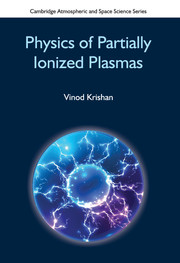Book contents
- Frontmatter
- Dedication
- Contents
- Figures
- Preface
- 1 Partially Ionized Plasmas Here and Everywhere
- 2 Multiflkuid Description of Partially Ionized Plasmas
- 3 Equilibrium of Partially Ionized Plasmas
- 4 Waves in Partially Ionized Plasmas
- 5 Advanced Topics in Partially Ionized Plasmas
- 6 Research Problems in Partially Ionized Plasmas
- Supplementary Matter
- Index
4 - Waves in Partially Ionized Plasmas
Published online by Cambridge University Press: 13 September 2017
- Frontmatter
- Dedication
- Contents
- Figures
- Preface
- 1 Partially Ionized Plasmas Here and Everywhere
- 2 Multiflkuid Description of Partially Ionized Plasmas
- 3 Equilibrium of Partially Ionized Plasmas
- 4 Waves in Partially Ionized Plasmas
- 5 Advanced Topics in Partially Ionized Plasmas
- 6 Research Problems in Partially Ionized Plasmas
- Supplementary Matter
- Index
Summary
We have developed the basic mathematical framework to study the dynamics of a partially ionized plasma as the three-fluid, the two-fluid, the single-fluid and the weakly ionized plasma systems in Chapter 2. The various equilibria of these systems have been explored in Chapter 3. We are now set to study the excitation of waves in these systems. The three-fluids in the presence of a magnetic field support a host of waves, depending upon the nature of the restoring forces. These forces come into play when a system is disturbed from its equilibrium state by a very tiny amount. The restoring forces tend to restore the system back to the equilibrium and the oscillations are set in, in the process. For example, a bend in the otherwise uniform magnetic field generates a restoring force which tries to straighten the field lines. Similarly, the compressions and the rarefactions in the system execute oscillations in an attempt to maintain a uniform mass density. The tiny disturbance to the equilibrium state ensures that the resulting oscillations have tiny but finite amplitudes which do not depend on the magnitude of the disturbance. The system is linearized about its equilibrium state. These circumstances generate a linear response of the system and the ensuing waves are said to be the linear waves. The linear response of the system gives the dispersion relation, the phase and the group speeds, the polarization and the relative estimates of the mechanical and the electromagnetic energy densities of the waves. The waves can be studied in each of the four descriptions of a partially ionized plasma given in Chapter 2. We shall begin with the fourth description, namely, the weakly ionized plasma, and then go on to consider the single-fluid (SPIF), the two-fluid and the three-fluid models.
Waves in a Weakly Ionized Plasma
A weakly ionized plasma is well described by the set of Eqs (2.220)–(2.226) along with the final form of the induction Eq. (3.245) including the time dependence. Let us write here the equations required to study the waves.
- Type
- Chapter
- Information
- Physics of Partially Ionized Plasmas , pp. 102 - 183Publisher: Cambridge University PressPrint publication year: 2016



